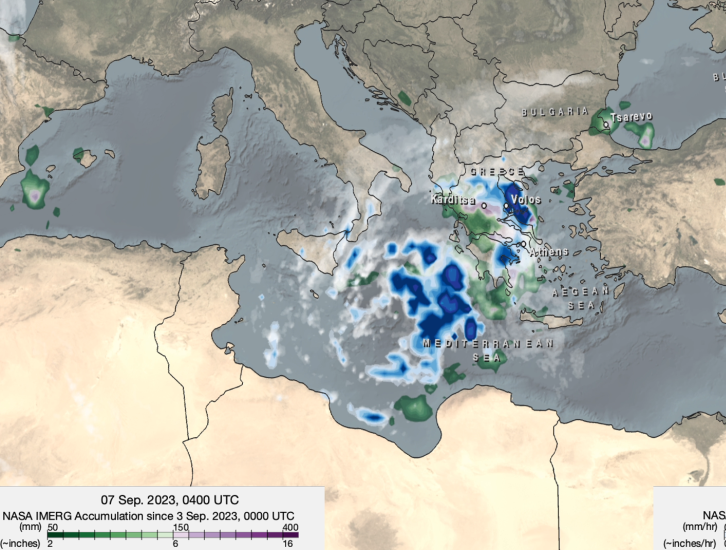
IMERG Captures Flooding Rainfall in Greece
On Sept. 4, 2023, a low-pressure system developed over southeastern Europe that would lead to devastating floods over Greece and other parts of the region. The system was given the name “Daniel” by local meteorological agencies. Daniel was dynamically driven by strong cyclonic flow in the upper-level winds over southeastern Europe. The upper-levels winds combined with low-level winds from the northeast which supplied moisture from the unusually warm waters of the Aegean and Black Seas to central Greece. According to satellite infrared and microwave estimates from NASA's MUR and NOAA’s OISST v2.1 products, sea surface temperatures over much of the Aegean Sea were 1 degree Celsius warmer than average, while temperatures over most of the western half of the Black Sea were between 2 and 4 degrees Celsius warmer than average in early Sept. 2023. Warmer sea surface temperatures can drive the transfer of heat and moisture to the lower atmosphere, leading to more favorable conditions for heavy precipitation.
Download video (right-click -> "Save As")
The above animation shows precipitation rates (in blue/yellow shading) and accumulations (in green/purple shading) from NASA’s IMERG multi-satellite product from Sept. 3 - 7, 2023. Cloudiness is shown in shades of white/gray using infrared geosynchronous satellite data.
Some of the worst flooding from Daniel was reported in the area near the city of Volos on the central-eastern coast of Greece, with several local gauges estimating values at or above ~16 inches (400 millimeters). IMERG estimated similar amounts of rainfall in that region (shown in dark purple colors). Flooding extended far inland as well, with cities and towns across central Greece seeing severe impacts from Daniel. The city of Karditsa, which also saw high accumulations from Daniel, was reported to have been set up as a staging area for evacuations from several local villages on Sept. 7. In addition to the flooding in Greece, the Bulgarian Black Sea coast was also affected by the storm system, including the town of Tsarevo, which saw accumulations over 6 inches (shown in light purple colors), leading to severe flooding.
While most conventional precipitation measurements are confined to areas near land-based weather stations, NASA’s IMERG product offers a unique view into extreme storm systems, such as Daniel, that cover the ocean as well as the land. By combining precipitation estimates from multiple satellites that cover the entire Earth, IMERG allows scientists and disaster monitoring professionals to see how precipitation varies across the entire path of extreme storms.
Credits:
Visualization and story by Jason West (NASA GSFC, PPS, KBR)

